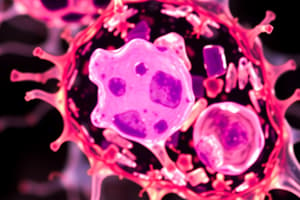Podcast
Questions and Answers
What is the basic unit of life according to cell theory?
What is the basic unit of life according to cell theory?
- Organ
- Organ system
- Cell (correct)
- Tissue
Which type of microscope can be used to view living cells?
Which type of microscope can be used to view living cells?
- Light Microscope (correct)
- Scanning Electron Microscope
- Transmission Electron Microscope
- Ultraviolet Microscope
What characteristic of life involves maintaining stable internal conditions?
What characteristic of life involves maintaining stable internal conditions?
- Reproduction
- Growth
- Homeostasis (correct)
- Response to stimuli
Which organelle is responsible for energy production in a cell?
Which organelle is responsible for energy production in a cell?
Which process breaks down glucose to release energy in the presence of oxygen?
Which process breaks down glucose to release energy in the presence of oxygen?
Which of the following is true about prokaryotic cells?
Which of the following is true about prokaryotic cells?
What is the main purpose of photosynthesis in plants?
What is the main purpose of photosynthesis in plants?
Which level of organization comes directly after cells in multicellular organisms?
Which level of organization comes directly after cells in multicellular organisms?
Flashcards
What are cells?
What are cells?
Cells are the smallest units of life that can exist independently. They are the basic building blocks of all living organisms.
What is cell theory?
What is cell theory?
Cell theory states that all living things are composed of cells, cells are the basic unit of life, and all cells arise from pre-existing cells.
Light Microscope
Light Microscope
A light microscope uses visible light to illuminate and magnify specimens. It can be used to view living cells and produces colored images, but has lower magnification and resolution compared to electron microscopes.
Electron Microscope
Electron Microscope
Signup and view all the flashcards
Prokaryotic Cells
Prokaryotic Cells
Signup and view all the flashcards
Eukaryotic Cells
Eukaryotic Cells
Signup and view all the flashcards
Anabolism
Anabolism
Signup and view all the flashcards
Catabolism
Catabolism
Signup and view all the flashcards
Study Notes
Cells
- Smallest self-sustaining units of life
- Basic building blocks of all living organisms
Cell Theory
- All living things are made up of cells
- The cell is the basic unit of life
- All cells arise from pre-existing cells
Microscopy
- Light microscopes view living cells, produce colored images, have low magnification and resolution
- Electron microscopes view ultrastructure of cells, produce black and white images, have higher magnification and resolution, only for non-living specimens.
Types of Cells
- Prokaryotic cells:
- No nucleus
- DNA in a loop
- Smaller ribosomes (70S)
- Lack membrane-bound organelles
- Pili and nucleoid present
- Eukaryotic cells:
- Nucleus
- Larger ribosomes (80S)
- Membrane-bound organelles
- Complex structure
Characteristics of Life
- Metabolism
- Growth
- Reproduction
- Homeostasis
- Response to stimuli
- Excretion
- Nutrition
Levels of Organization in Multicellular Organisms
- Cells → Tissues → Organs → Organ Systems → Organism
Organelles and Functions
- Nucleus: Stores genetic information
- Mitochondria: Energy production (ATP)
- Chloroplast: Photosynthesis (in plants)
- Ribosomes: Protein synthesis
- Cell Wall: Protection and structure (plants and prokaryotes)
- Plasma Membrane: Regulates material entry and exit
Metabolism
- Anabolism: Builds complex molecules (e.g. photosynthesis)
- Catabolism: Breaks down molecules (e.g. respiration)
Cellular Respiration
- Aerobic: Requires oxygen, high ATP yield, produces water and carbon dioxide
- Anaerobic: No oxygen required, low ATP yield, produces lactic acid (humans), or ethanol (yeast)
Photosynthesis
- Converts light energy into glucose in plants
- Limiting factors include light intensity, carbon dioxide, and temperature
Prokaryotic vs Eukaryotic Comparison
| Feature | Prokaryotic Cells | Eukaryotic Cells |
|---|---|---|
| Nucleus | Absent | Present |
| Organelles | Non-membrane-bound | Membrane-bound |
| Ribosomes | 70S | 80S |
Microscopy Comparison
| Feature | Light Microscope | Electron Microscope |
|---|---|---|
| Magnification | Up to 400x | Up to 1,000,000x |
| Resolution | Low | High |
| Image Type | Colored | Black and white |
| Living Specimens | Yes | No |
Study Tips
- Draw and label diagrams of prokaryotic, plant, and animal cells.
- Practice comparing cell types and microscopes.
- Memorize life processes and organelle functions.
- Review aerobic vs. anaerobic respiration and photosynthesis limiting factors.
Activities
- Complete a timeline of contributions to cell theory.
- Create a Venn diagram comparing microscopes.
- Research unicellular organism life processes.
Studying That Suits You
Use AI to generate personalized quizzes and flashcards to suit your learning preferences.
Related Documents
Description
Explore the foundational concepts of cells, including their structure, types, and the principles of cell theory. This quiz covers the characteristics of life, microscopy techniques, and the levels of organization in multicellular organisms. Test your knowledge about prokaryotic and eukaryotic cells and their roles in living systems.



